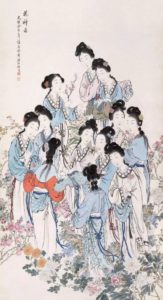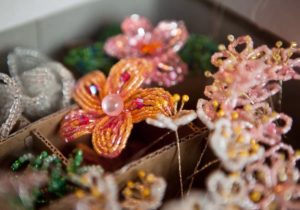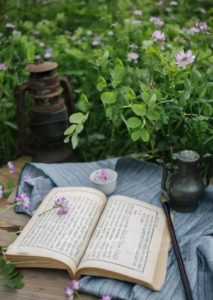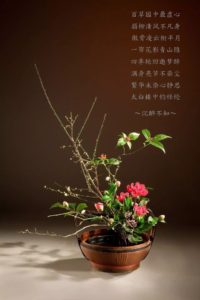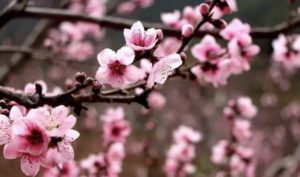花朝节是我国民间的岁时八节之一,也叫花神节,俗称百花生日。花朝节与气候时令关系密切,故而具体日期因地而异,论节气,大约在“惊蛰”到“春分”之间。此时春回大地,万物复苏,草木萌青,百花或含苞或吐绽或盛开。这天,各地的百姓,尤其是花农,都要祭百花以求庇佑。
唐代花朝定为二月十五,还成为和“正月十五元宵节”“八月十五中秋节”并列的三个“月半”佳节;到了宋代,花朝节于某些地方被提前到二月十二或二月初二的——或许是对春的迫不及待吧。
一方面因循唐宋主流,一方面取月半吉日,我们的花朝活动日期定在夏历二月十五,即公历3月31日。 –汉协会邀您共度花朝
日期:2018.3.31 (星期六)
时间:11:00 AM – 8:00 PM
CCA汉文化山庄
33 Tao Road, Catskill, New York
(GPS 请使用 186 Paradise Lake Road)
网上付费:
普通价:$38/人
优惠价(学生、62岁以上老人、自带汉服者):$20/人
前台付费:
$48/人
优惠价(学生、62岁以上老人、自带汉服者):$30/人
**会员及5岁以下儿童享受免费入场
**购买优惠价和享用免费入场的来宾需要在入场出示相关证件(如会员证明、学生证、证明年龄的身份证等)
其他费用:
往返车费:$30/人
租用汉服:$20/套
活动入场预订:
无论是哪种付款方式,请一定要填写活动入场预订表格! https://docs.google.com/forms/d/e/1FAIpQLScRyn2RK_SUokj5_Ui17e38lfHjvTnitM7A8fPyenJD6g3doQ/viewform?usp=sf_link
网上预付链接:
PayPal:
Venmo:
Chase QuickPay:
Chinese Cultural Association Inc
Email: jl@hancca.org
联系方式:
网站: hancca.org
电话: 888-252-9618
邮箱: jl@hancca.org
花朝时间
11:00 PM – 12:00 PM 登记,抽花签,着汉服,源起花朝节
12:00 PM – 12:30 PM 祭花神
12:30 PM – 1:30 PM CCA花宴
1:30 PM – 3:00 PM 和专业老师学插花
3:00 PM – 3:30 PM 花茶盛开:CCA及会员分享介绍
3:30 PM – 5:30 PM 种植希望之树,绑彩带、祝福来;巧手花簪;DIY 做花糕
5:30 PM – 6:00 PM 花糕、花簪一起秀
6:00 PM – 6:30 PM 飞花令
6:30 PM – 7:30 PM 山庄特色晚宴
7:30 PM – 8:00 PM 歌舞表演
8:00 PM – 8:30 PM 收拾离场
During the Tang Dynasty, the 15th of February on the Chinese lunar calendar was marked by the Flower Festival. Though over time, the exact date of the Flower Festival varied region by region to range from February 2 to February 12, its core essence remained the same — it is a celebration in anticipation of Spring, of renewal and awakening after the cold of winter.
We invite you this year on March 31- or rather the 15th of February – to join us in continuing this tradition and welcome in Spring!
Date: Saturday, March 31, 2018
Time: 11:00 AM – 8:00 PM
Location: CCA Estate, 33 Tao Rd, Catskills, NY
*If using GPS, please search 186 Paradise Lake Road
Event Cost and Registration
Online:
General Admission: $38/Person
Discount Admission (Students, seniors 62+ or wearing Hanfu): $20/Person
At Door:
General Admission: $48/Person
Discount Admission (Students, seniors 62+ or wearing Hanfu): $30/Person
**Free for members and children under 5
**Please show ID for discounted admissions
We also offer transportation to/from NY: $30/Person and Hanfu rentals: $20/Set
Reservation Form (required for all attendees, regardless of payment method):
Online Payment:
PayPal:
Venmo:
Chase QuickPay:
Chinese Cultural Association Inc
Email: jl@hancca.org
Contact Info:
Web: hancca.org
Tel: 888-252-9618
Email: jl@hancca.org
![]()
Schedule of Activities:
11:00 PM – 12:00 PM Check-in and Lucky Flower Draw;Introduction on the Flower Festival
12:00 PM – 12:30 PM Worship of the Flower Goddess
12:30 PM – 1:30 PM Flower Banquet Lunch
1:30 PM – 3:00 PM Art of Flowers: Create your own!
3:00 PM – 3:30 PM Tea time: Sample traditional flower teas
3:30 PM – 5:30 PM Plant your own “Blessing Tree” ;DIY Flower Cake and Flower Hairpin
5:30 PM – 6:00 PM ~ Break ~ (Tea, Snacks, Creations Showcase)
6:00 PM – 6:30 PM “Flowers in Flight”
6:30 PM – 8:00 PM Dinner and Performances
8:00 PM – 8:30 PM Farewell and Departure
*********************************************************************
源 起
游 春 植 树
古时,每逢花朝,文人雅士邀三五知己,赏花之余,饮酒作乐,互相唱和,高吟竟日。纵观二三月间的传统佳节会发现,这一时期会有一系列游春的节日——春节拉开了迎春的序幕,花朝节前后构成游春的高潮。
春天,万木向春。本次活动,我们精心准备了年轻的花树、果树,邀请您和朋友、家人领取一个希望,无论是友情、亲情和爱情,美好的期许与祝福定会随着希望之树成长壮大,CCA将帮助您定期记录它成长的过程,而您将作为我们的首批花园嘉宾的支持者,未来将优享属于您的美好果实。
Origins
Worship of Flower Goddess
In traditional Chinese belief, the Flower Goddess nurtures and protects the multitude of Earth’s floral and fauna. She is recorded in the Huai Nan Zi as being ruler over her domain, directing and managing over her subjects. As such, in agrarian China, the Flower Goddess held a place of great significance as worshipper entrusted her to guard over their yearly plantings.
Taoists writing had alluded to a unnamed “god of flowers” ever since the Ming Dynasty. By the middle of the Qing Dynasty, names of legendary figures from the Tang and Song Dynasties had become attached to a group of Twelve Flower Gods – each overseeing a different month and paintings depicting the Flower Gods gained in popularity.
Art of Flowers
The Art of Flowers traces its roots back to pre-Qin Dynasty China. Tang Dynasty China saw the art of flowers taking on significance as an outward sign of elegance and cultivation in court life and temples. It was during this time also that the art form was transported to Japan where it gained popularity among the aristocracy and was further refined and codified into ikebana. In China, it was during the Song Dynasty that the art of flowers truly flourished and was widely practiced among the common folk.
The biggest difference between Eastern art of flowers and Western floral arrangement lies that whereas floral arrangement stresses external form, the art of flowers emphasizes the creation of an inner beauty and balance.
Flower Teas
There are two types of flower teas – tea made from flower blossoms and “scented” flower tea. Violet, rose and chrysanthemum teas are examples of the former. The latter is made through a special process whereby flower blossoms are baked with tea leafs during the baking step of tea processing in order to infuse the fragrance directly into the tea leaves. The flowers are then picked-out by hand and the step repeated until a desired scented level. The quality of such teas is ranked by the balance of taste between the flower fragrance and the base tea. Traditional “scented” flower teas include jasmine tea, magnolia tea, and osmanthus tea.
Blessing Trees
In ancient times for the the Flower Festival, Chinese literati (learned-scholars) would gather under outdoor pavilions to indulge in the unfolding scenergy and exchange calligraphy compositions, poetry recitations and elegant drinks.
Tying Eastern and Western traditions, we wish to celebrate on this occasion the Spring Equinox as well by planting young flowering fruit trees. We cordially invite everyone to plant a tree, cast a wish, tie it to the tree (ribbons will be provided) and watch the tree and blessings grow with time.
CCA will help you keep watch over your tree as it matures from a young seedling into adulthood. Every year, you’ll be able to enjoy the beautiful flowers as your tree blossoms in anticipation of Spring. And who knows, maybe by next summer you’ll be enjoying salivating fresh tree-ripened fruits as well!
Flower Hairpins
While it is difficult to ascertain exact historical roots, female figurines unearthed from Han Dynasty tombs in Chengdu, Sichuan Province featured elaborate flower hairpins with gigantic chrysanthemums in the middle of the bun flanked by several smaller flowers on both sides. Hairpins made from fresh flowers have remained popular since. In contrast to the jewel encrusted hairpins of the aristocrats, fresh flowers served as simple yet elegant alternatives for the common folk. Different festivals called for different flowers. In general, hairpins worn in the spring incorporated peonies, apricot and peach blossoms; summer saw camellia and jasmine; autumn featured chrysanthemum and okra; while winter was for plum and cherry blossoms.
Flower Cake
The Flower Festival developed during the Tang Dynasty to include its own associated traditions and foods. It is told that the Empress Wu loved flowers so much that every year, towards the day of the Flower Festival, she would order her maids to collect flowers, ground the petals together with rice and steam into cakes. Flower cakes were also given as rewards to ministers and officials of the court. Taste this Flower Festival not only the sweetness of the flowers but also a journey back in time.
“Flying Flowers”
China is the land of flowers and poetry. “Flying Flowers” is originally an “elegant” drinking game enjoyed by literati. Typically, the first person would quote a verse of no more than seven characters from a poetry or prose, the second person would need to recite something that had the first character of that line, say “flower” as the second character, the third person quote something that had “flower” as the third character and so on and so forth. The person who broke the rule would take a drink as a penalty.
Drinking games are considered an integral part of Chinese culture. The roots traces back to the Zhou Dynasty and is viewed as an extension of the Confucian emphasis on “rites”. Drinking showcased a host’s hospitality towards guests while the games aspect added a layer intellectualism and turned the drinking into an art form unto itself.
Let’s get ready to play!




